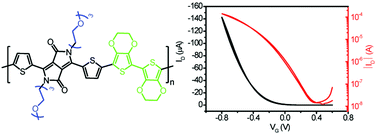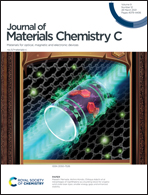Ethylenedioxythiophene incorporated diketopyrrolopyrrole conjugated polymers for high-performance organic electrochemical transistors†
Abstract
The synthesis of conjugated polymers specifically for organic electrochemical transistors (OECTs) has attracted much attention recently for their great potential in biological applications. In this case, not only the carrier mobility but also the ionic conduction capability and redox stability of the polymers in an aqueous environment are critical to the device performance. Here, we report a series of dithienyldiketopyrrolopyrrole (DTDPP) based polymers used in organic electrochemical transistors (OECTs). With the combination of ethylenedioxythiophene (EDOT) and glycolated side chains, the optimized polymers present low ionization potential and ultrahigh volumetric capacitance. The resultant OECTs show high transconductance, a high on/off ratio, low threshold voltage, fast response time and remarkably high stability in aqueous solutions. Furthermore, various short-term synaptic functions are successfully mimicked through the optimization of electrolytes and operation modes, indicating that the DPP-based polymer is promising for broad applications in bioelectronics.



 Please wait while we load your content...
Please wait while we load your content...